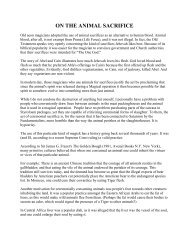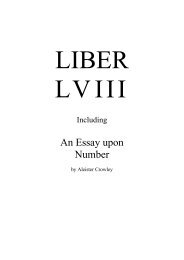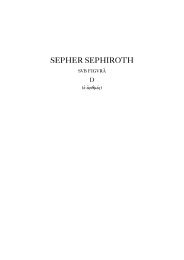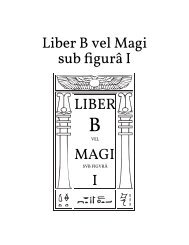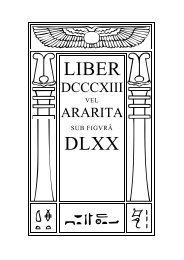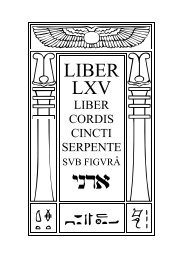Annotated Ritual of the Eucharist
Annotated Ritual of the Eucharist
Annotated Ritual of the Eucharist
Create successful ePaper yourself
Turn your PDF publications into a flip-book with our unique Google optimized e-Paper software.
He elevates <strong>the</strong> Host and <strong>the</strong> Cup.<br />
The Bell strikes. 101<br />
ΑΓΙΟΣ ΑΓΙΟΣ ΑΓΙΟΣ ΙΑΩ.<br />
1<br />
3 2<br />
5 4<br />
He replaces <strong>the</strong> Host and <strong>the</strong> Cup, 102 and adores.<br />
VII: OF THE OFFICE OF THE ANTHEM 103<br />
[Two an<strong>the</strong>ms are given in <strong>the</strong> present edition <strong>of</strong> <strong>the</strong> text. The first is <strong>the</strong><br />
Tu Qui Es, designated for <strong>the</strong> purpose by Sir Aleister Crowley;<br />
and it is <strong>the</strong> first <strong>of</strong> its kind, <strong>the</strong> fa<strong>the</strong>r <strong>of</strong> all o<strong>the</strong>rs. 104<br />
[The second an<strong>the</strong>m is “The Rhapsody <strong>of</strong> Chrisippus,” also from a text<br />
by Sir Aleister Crowley, edited by Dionysos Thriambos to serve<br />
as an an<strong>the</strong>m, and approved for use by <strong>the</strong> Patriarch Hymenæus<br />
Beta in Anno Legis IV iv . The imagery <strong>of</strong> <strong>the</strong> alternate an<strong>the</strong>m<br />
focuses on <strong>the</strong> cosmic and celestial, ra<strong>the</strong>r than <strong>the</strong> vegetative and<br />
organic orientation <strong>of</strong> <strong>the</strong> Tu Qui Es.<br />
97 This time, <strong>the</strong> Priestess should hold <strong>the</strong> cup above <strong>the</strong> paten. I make <strong>the</strong>se three crosses in red.<br />
98 As with earlier genuflections, this gesture is a momentary drop to one knee. The Priest should resume his<br />
feet for <strong>the</strong> subsequent actions.<br />
99 The Priestess keeps <strong>the</strong> cup over <strong>the</strong> paten, so that <strong>the</strong> Priest can take up <strong>the</strong> Host and hold it above <strong>the</strong> cup,<br />
without ever exposing <strong>the</strong> Host to <strong>the</strong> floor. Both cup and paten remain in <strong>the</strong> center lines <strong>of</strong> <strong>the</strong> temple, Priest<br />
and Priestess.<br />
100 I make <strong>the</strong>se five crosses on <strong>the</strong> mouth <strong>of</strong> <strong>the</strong> cup in brilliant white.<br />
101 We have no authoritative guidance on who should sound <strong>the</strong> bell. Customarily it is <strong>the</strong> Deacon, who may<br />
keep it at <strong>the</strong> altar <strong>of</strong> incense for this purpose. It could just as conceivably be rung by <strong>the</strong> Priestess or one <strong>of</strong><br />
<strong>the</strong> children, a musician, or even a member <strong>of</strong> <strong>the</strong> congregation with no o<strong>the</strong>r specific responsibilities. Also<br />
unstated is <strong>the</strong> number <strong>of</strong> chimes. A single “strike” is obviously <strong>the</strong> simplest answer. Some clergy prefer a<br />
threefold bell, based on <strong>the</strong> threefold hagios, as well as Catholic Christian tradition. I actually favor a sixfold<br />
chime <strong>of</strong> bells, in keeping with <strong>the</strong> The Ship (<strong>the</strong> Masonic mystery-play dedicated to O.H.O. Theodor Reuss, for<br />
which Crowley first wrote <strong>the</strong> Tu Qui Es).<br />
102 The cup must be re-covered at this point.<br />
103 It is best for <strong>the</strong> people to stand for <strong>the</strong> entire an<strong>the</strong>m. They must be on <strong>the</strong>ir feet if <strong>the</strong>y are to participate<br />
with open voices in <strong>the</strong> choruses, and it would be clumsy for <strong>the</strong>m to rise in <strong>the</strong> middle <strong>of</strong> <strong>the</strong> an<strong>the</strong>m.<br />
104 Various tunes have been used for singing <strong>the</strong> Tu Qui Es. I prefer <strong>the</strong> one composed by <strong>the</strong> U.S. Grand<br />
Organist Fr. H.K. 1131, for which scores are available.<br />
Liber XV with Practical Annotations by T Polyphilus, Ep. Gn. 20



